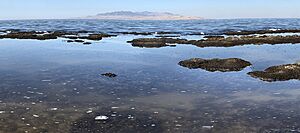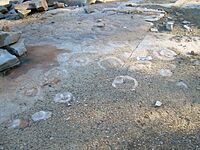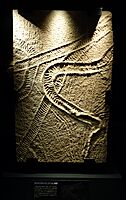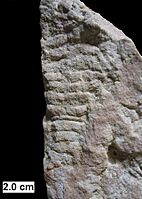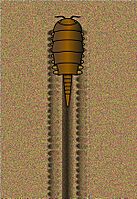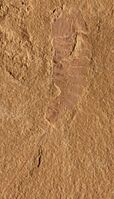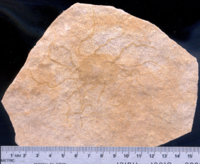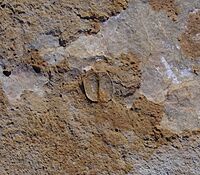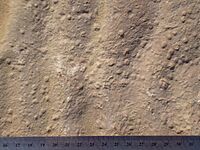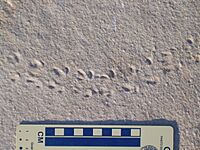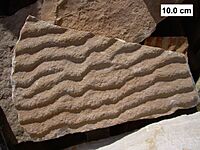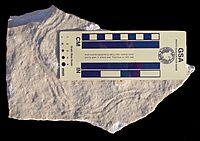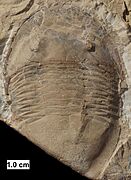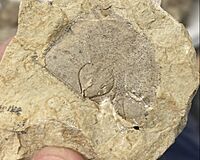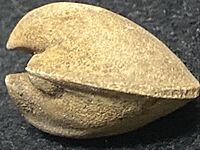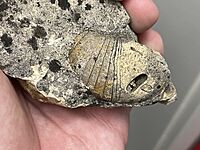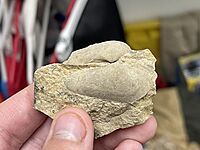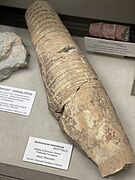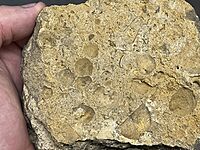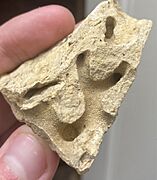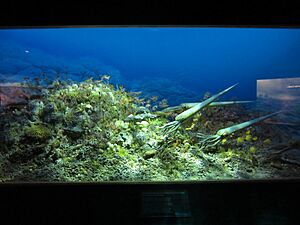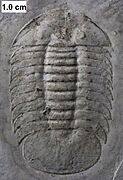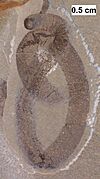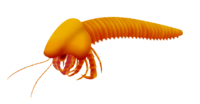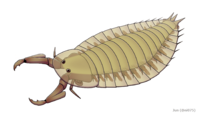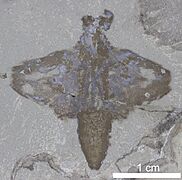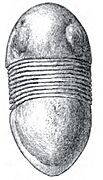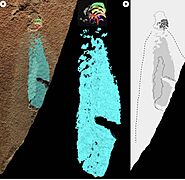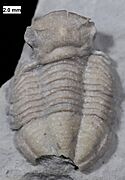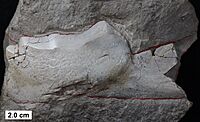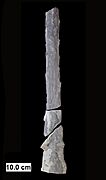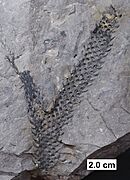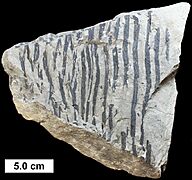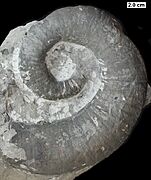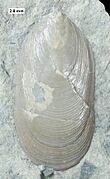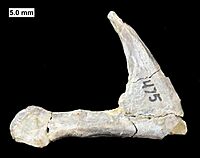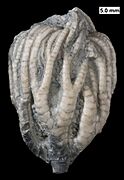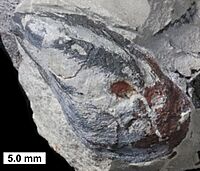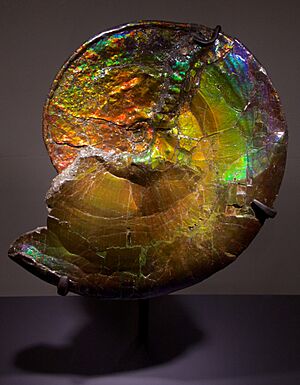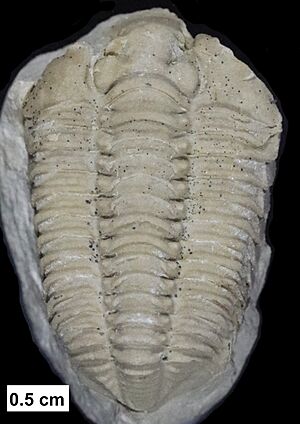Paleontology in Wisconsin facts for kids
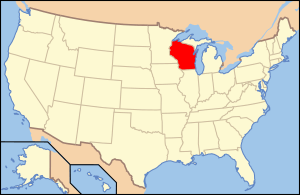
Paleontology in Wisconsin is all about finding and studying fossils in the U.S. state of Wisconsin. The state has fossils from very old times, like the Precambrian and most of the Paleozoic Era. It also has some fossils from the Mesozoic and later Cenozoic Eras. Most of the Paleozoic rocks formed in the ocean.
Wisconsin's fossil record is a bit hidden. This is because a thick layer of Pleistocene glacier sediment covers most of the rock layers. But even with this, some fossil finds in Wisconsin offer amazing clues. They help us understand the history and variety of life on Earth.
Contents
Ancient Life in Wisconsin
Precambrian Fossils
In north-central Wisconsin, you can find many types of rocks. These include metamorphic, igneous, and sedimentary rocks. Most of these rocks do not have fossils. However, some of the sedimentary ones contain stromatolites. Stromatolites are layered structures made by tiny microbes, like ancient bacteria.
Cambrian Life and Fossils
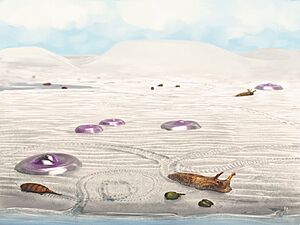
Cambrian rocks are found in western and central Wisconsin. Many of these rocks contain fossils. You can see them especially along the Mississippi River, Saint Croix River, and Wisconsin River. Most of these rocks are from the Upper Cambrian period. Some might even be from the Middle Cambrian.
Scientists have found fossils of many different creatures here. These include stromatolites, brachiopods (shellfish), gastropods (snails), trilobites (ancient sea bugs), and graptolites (tiny colonial animals). Wisconsin's Cambrian rocks have also given us more types of aglaspidids than any other state. Aglaspidids are arthropods, close relatives of trilobites.
A special place in central Wisconsin is called Blackberry Hill. It's a famous fossil site because it has many types of trace fossils. Trace fossils are things like footprints or trails left by animals. This site also has many stranded jellyfish fossils. Most importantly, Blackberry Hill has fossils of one of the first animals to walk on land. This animal was a type of euthycarcinoid.
-
Stranded scyphozoans (jellyfish) at Blackberry Hill.
-
The Cambrian trilobite Prosaukia from Prairie du Sac.
-
A fossil showing the right side of Cyclopites. This is an aglaspidid arthropod from the Saint Lawrence Formation in Baraboo.
-
Fossils of sand stromatolites on rippled sandstone.
-
Fossils of wave ripple marks with a microbial mat fossil on top.
Ordovician Ocean Life
Many fossil-rich Ordovician rocks are found in southwestern Wisconsin. During this time, most of Wisconsin was covered by a shallow, warm ocean. This ocean was full of life!
Fossils from this period include many types of stromatolites, fungi, sponges, and corals. There are also bryozoans (tiny colonial animals), brachiopods, gastropods, bivalves (clams), and nautiloids (shelled cephalopods). Trilobites, ostracods (small crustaceans), and crinoids (sea lilies) are also common.
-
The Illaenidae trilobite Thaleops from the Sinnipee Group in Dane County.
-
The imprint of the nautiloid Trocholites from the Sinnipee Group in Dane County.
-
The main fossil of Actinoceras beloitense from the Platteville Limestone.
Silurian Reefs and Strange Creatures
Fossil-rich Silurian rocks are found in eastern Wisconsin. They stretch from the Door County peninsula down to the Illinois border. Fossils include stromatolites, sponges, corals, bryozoans, brachiopods, gastropods, bivalves, nautiloids, trilobites, and jawless fish bones.
During the Middle-Late Silurian period, the area around modern Milwaukee had a huge reef system. The animals living there at that time were very diverse. It was one of the most varied groups of animals for its age in all of North America. Donald G. Mikulic called it "a textbook example of ancient reefs."
Another important site is the Waukesha Biota. This is a special fossil site known for its incredibly well-preserved fossils. Scientists have found strange arthropods, worms, and other creatures here. Many of these had never been seen before in Silurian rocks. Some of the unique fossils from Waukesha Biota include a synziphosurine (a relative of horseshoe crabs), a possible cheloniellid, and a bizarre arthropod called Parioscorpio. There's also the mysterious Waukesha butterfly animal.
-
Venustulus, a synziphosurine arthropod. It's a distant relative to modern horseshoe crabs from the Waukesha Biota.
-
Parioscorpio, a mysterious arthropod from the Waukesha Biota. It has been thought to be a crustacean, a trilobite relative, or even a scorpion.
Devonian Fish and Plants

Four Devonian rock layers are found in southeastern Wisconsin, near Milwaukee. All of them contain some fossils. One of these, the Milwaukee Formation, is very important. It has one of the most diverse groups of animals and plants from its time (the late Givetian age).
Its fossils include tiny foraminifers, corals, bryozoans, brachiopods, and many types of mollusks. There are also annelid worms, trilobites, and crinoids. Most exciting are the fish fossils, including placoderms (armored fish), sharks, and sarcopterygians (lobe-finned fish). Fossils of land plants and fungi have also been found. The Milwaukee Formation also has many types of trace fossils.
-
A jaw plate from the Devonian placoderm Eastmanosteus pustulosus from the Milwaukee Formation.
-
A Lycopod branch from the Milwaukee Formation.
-
Bark (possibly from a cladoxylopsid) from the Milwaukee Formation. It was first thought to be a sea plant.
-
The tooth of the sarcopterygian fish Onychodus from the Milwaukee Formation.
-
The shell of the nautiloid cephalopod Gyronaedyceras from the Milwaukee Formation.
Permian to Neogene: Missing Fossils
Rocks from the Permian to Neogene periods are rarely found in Wisconsin. This is because they were either not laid down much, or they were worn away. The huge glaciers of the Pleistocene Ice Age also eroded many rocks. Because of this, dinosaurs and other animals from these times did not leave many fossils in Wisconsin.
However, some ammonite fossils have been found. These came from the Coleraine Formation and date to the middle Late Cretaceous period. They were found mixed in with glacial debris. These include the species Placenticeras pseudoplacenta and Scaphites carlilensis.
Quaternary: Ice Age Animals
During the Quaternary period, new layers of sediment were laid down. But the climate became very cold. Glaciers eventually covered almost all of Wisconsin. Wisconsin has sediments from all the Pleistocene glacial stages. The most famous stage is even named after the state.
During this time, hemlock and spruce trees formed forests. These forests were home to amazing creatures. These included giant beavers, horses, and woolly mammoths.
History of Paleontology in Wisconsin

Increase Allen Lapham was a very smart naturalist. He is known as Wisconsin's first geologist. In the late 1830s, Lapham found many different fossils near Milwaukee. He wondered how these rocks related to those studied in New York by James Hall.
Lapham sent many of his fossils to Hall in 1846. Hall began studying the area. In 1862, he realized that the local rock formations were ancient reefs. These Silurian-aged reefs in the Milwaukee area were the first Paleozoic reefs in the world to be described in scientific writings. They were also the first fossil reefs in North America to be correctly identified.
Hall began to describe the fossils from the reef. He found them to be among the most diverse for that time period in all of North America. Sadly, Lapham died in 1875. Most of his fossils were sold to the University of Wisconsin. Even worse, most of them were destroyed in a fire nine years later.
In the late 1800s, "gentleman naturalists" explored the region. They collected fossils for Hall and other famous paleontologists. These collectors included T. A. Greene and E. E. Teller near Milwaukee. P. R. Hoy collected near Racine, and F. H. Day collected in the Wauwatosa area.
In 1877, T. C. Chamberlin's research showed differences in the rocks with reefs compared to those without. Donald G. Mikulic praised Chamberlin's work on the Milwaukee reefs. He called it a "classic work" in understanding ancient environments and how rocks form. In the early 1900s, scientists like W. C. Alden and A. W. Grabau also studied these reefs. Over time, scientific interest in the Silurian reefs of Milwaukee decreased as local quarrying slowed down.
Lapham, Greene, Teller, Day, and another naturalist, C. E. Monroe, also gathered many fossils from the Devonian Milwaukee Formation. Most of these fossils came from cement quarries. These quarries operated between 1876 and 1911 along the Milwaukee River. This area is now Estabrook and Lincoln Parks. Greene and others would pay quarry workers for their fossil finds. This led to many high-quality fossils being found.
These fossil beds soon became famous for having one of the most diverse Devonian fish fossil collections in the United States. Most of these fossils are now in museums. These include the Thomas A. Greene Geological Museum and the Milwaukee Public Museum. Much of this material has not been deeply studied for over a hundred years. However, a recent study in 2019 suggests that the Milwaukee Formation has one of the richest and most diverse fossil collections for its age in North America.
Other important recent discoveries in Wisconsin paleontology include the Waukesha Biota and Blackberry Hill. We talked about these earlier.
The Silurian trilobite Calymene celebra was chosen as Wisconsin's state fossil in 1985.
People in Wisconsin Paleontology
- Roy Chapman Andrews was born in Beloit on January 26, 1884.
- Amadeus William Grabau was born in Cedarburg on January 9, 1870.
- Everett C. Olson was born in Waupaca on November 6, 1910.
Natural History Museums
- Cable Natural History Museum, Cable
- Milwaukee Public Museum, Milwaukee
- Thomas A. Greene Geological Museum, Milwaukee
- University of Wisconsin–Stevens Point Museum of Natural History, Stevens Point
- UW–Madison Geology Museum, Madison
- Weis Earth Science Museum, Menasha


